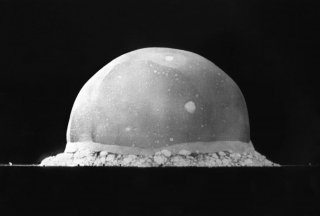Could Iran Test a Nuclear Bomb Within a Year?
“Iran could test a nuclear weapon in the desert within a year now,” said former IAEA inspector David Albright, founder of the Institute for Science and International Security, at a conference call hosted by the Foundation for Defense of Democracies. “I think it would take them longer to have a missile deliverable nuclear warhead, but often countries don't do that first.”
A new International Atomic Energy Agency report reveals that Iran has doubled its stockpile of enriched uranium since February, but experts disagree on how quickly the country could build a nuclear bomb if it wanted to.
Iran had agreed to limit its nuclear program under the JCPOA, a 2015 deal with six world powers. U.S. President Donald Trump declared the agreement the “worst deal ever” and pulled out of it in 2018, prompting Iran to begin stockpiling nuclear materials that could eventually be used to make a weapon.
But it is difficult to tell how much closer Iran is to actually building a bomb.
“Iran could test a nuclear weapon in the desert within a year now,” said former IAEA inspector David Albright, founder of the Institute for Science and International Security, at a conference call hosted by the Foundation for Defense of Democracies. “I think it would take them longer to have a missile deliverable nuclear warhead, but often countries don't do that first.”
Other experts disagreed.
"To say that Iran could test a weapon in a year rests on heroic assumptions" about Iran's engineering capabilities and luck, said former U.S. diplomat Mark Fitzpatrick, now an associate fellow at the International Institute for Strategic Studies. “The only real calculation one could make is how long it would take Iran to produce enough highly-enriched uranium to make a weapon.”
Iran would not only have to accumulate enough nuclear material to build a bomb, but also fashion it into a weapon alongside other components.
Iranian scientists could take a year “before they could solve all those other engineering problems,” according to Jarrett Blanc, who oversaw JCPOA implementation at the State Department and is now a senior fellow at the Carnegie Endowment for International Peace.
All three experts—Albright, Fitzgerald, and Blanc—agreed that Iran was now closer to accumulating enough nuclear material to build a bomb than it was in 2017.
Albright claimed that Iran could do this within three months as the “lowest credible number.”
Fitzpatrick, however, said that Iran still has less enriched uranium than it did before the JCPOA, telling the National Interest by email that “at the current rate of accumulation it would take more than three years to get to the point they were at in 2015.”
IAEA inspectors could raise an alarm before any of this happened, emphasized Richard Johnson, senior director for fuel cycle and verification at the Nuclear Threat Initiative.
“Iran can either do this quickly, or they can do it in secret,” said Johnson, who oversaw Iranian nuclear issues at the State Department until 2018.
He said that there would be “intensive monitoring and verification before you get to the flash in the desert” because Iran has continued to allow the United Nations watchdog to inspect its nuclear facilities, even after discarding other parts of the JCPOA.
“That is not going to be the first indication if Iran decides it’s going to try to race towards a nuclear bomb—a mushroom cloud,” Johnson said. “I would argue that this is the point of the JCPOA.”
Matthew Petti is a national security reporter at the National Interest. Follow him on Twitter: @matthew_petti.


